Free Agent Stock Watch: Travis Etienne
Regime change has been a common occurrence during Travis Etienne‘s Jacksonville tenure. Although only two GMs have been in place during the former first-round pick’s time in Duval County, the team has effectively gone through three power structures during the RB’s five-season run.
The coach who drafted Etienne (Urban Meyer) proved unfit for NFL leadership but held full personnel control during his eventful several months on the job. Meyer had shown interesting transparency on the night the Jaguars chose Etienne, indicating the team wanted Kadarius Toney with the second of its first-round picks that night. GM Trent Baalke took over as the lead personnel exec following Meyer’s ouster, but Shad Khan fired him as the unpopular exec had affected the team’s 2025 HC search. The James Gladstone–Liam Coen power structure now controls Etienne’s future — until March, that is.
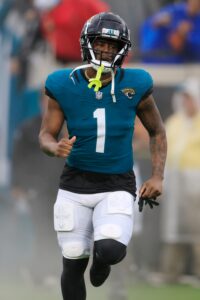 After a down 2024 during a disastrous Baalke-Doug Pederson finale, Etienne looked like he was fading out of the picture this offseason. Trade rumors emerged, with the Clemson alum’s fit in Coen’s offense questioned, and the Jags added two Gladstone-tabbed draftees (Bhayshul Tuten, LeQuint Allen) at the position. Those two crowded the backfield, after Tank Bigsby had forced a timeshare with Etienne last season. But Bigsby ended up being the one moved. This has smoothed Etienne’s runway to impress in a contract year.
After a down 2024 during a disastrous Baalke-Doug Pederson finale, Etienne looked like he was fading out of the picture this offseason. Trade rumors emerged, with the Clemson alum’s fit in Coen’s offense questioned, and the Jags added two Gladstone-tabbed draftees (Bhayshul Tuten, LeQuint Allen) at the position. Those two crowded the backfield, after Tank Bigsby had forced a timeshare with Etienne last season. But Bigsby ended up being the one moved. This has smoothed Etienne’s runway to impress in a contract year.
Entering Week 5, Etienne leads the NFL with 6.1 yards per carry. His 394 rushing yards rank trail only Jonathan Taylor and James Cook this season. Both Cook and Taylor entered the season entrenched as their teams’ starting running backs. The Tuten-Allen draft class and Bigsby’s presence clouded Etienne’s Jacksonville future, but a 143-yard opener — highlighted by a 71-yard run — showed the potential for a contract-year bounce-back effort.
The Jags traded Bigsby to the Eagles for fifth- and sixth-round picks days later, and Etienne has regained his role as the backfield leader. Etienne also posted a 100-yard rushing performance against the 49ers, giving the Jags a road upset over a team with a high-level defense. We are only at the quarter pole for the season, but Etienne’s free agency value has increased based on his start and return to surefire RB1 duty in Jacksonville.
The ex-Trevor Lawrence college teammate had held this position in 2022 and ’23, submitting back-to-back 1,000-yard seasons after missing his rookie year with a Lisfranc injury. A costly fumble at the goal line during a narrow Week 1 loss to the Dolphins proved a harbinger of a step backward last year, however, as Etienne stumbled to a 558-yard season in 15 games. Bigsby also outgained him by a wide margin, tallying 766 yards. The landscape looks different for Etienne post-Bigsby, and the 2026 free agent market also lost some key names this summer.
Both Cook and Kyren Williams signed extensions, moving two 2022 draftees out of the free agent picture. Etienne became grouped with the 2022 draft class due to the Jags picking up his fifth-year option — an affordable $6.14MM — in May 2024. The rest of the 2021 RB class has already moved onto second contracts. The other first-round RB that year, Najee Harris, saw his fifth-year option declined and joined the Chargers in free agency. The Patriots and Panthers respectively extended Rhamondre Stevenson and Chuba Hubbard on similar deals — pacts that certainly could be relevant for Etienne.
The New England and Carolina RBs are tied to $9MM- and $8.3MM-per-year extensions, respectively. The contracts check in outside the top 10 in RB AAV. Etienne will need to stick the landing on this turnaround campaign if he is to move toward the Cook-Williams level; the Bills and Rams gave their respective starters $11MM- and $11.5MM-AAV extensions. Another sizable cap increase would help the five-year Jaguar’s cause, but matching the Cook and Williams numbers might be overly optimistic for a player whose value has fluctuated.
 Etienne having a better resume compared unsigned 2022 draftees Breece Hall and Kenneth Walker could make him the top RB available next year, but age also stands to be a factor for the Jags ballcarrier. Hall is in an age-24 season, while Walker will turn 25 this month. Because Etienne both surprised by staying at Clemson for his 2020 senior season and was then restricted by the fifth-year option, he will be 27 when free agency opens. That is certainly on the older end for a first-time RB UFA.
Etienne having a better resume compared unsigned 2022 draftees Breece Hall and Kenneth Walker could make him the top RB available next year, but age also stands to be a factor for the Jags ballcarrier. Hall is in an age-24 season, while Walker will turn 25 this month. Because Etienne both surprised by staying at Clemson for his 2020 senior season and was then restricted by the fifth-year option, he will be 27 when free agency opens. That is certainly on the older end for a first-time RB UFA.
Among RBs, only Etienne and Saquon Barkley have seen their fifth-year options exercised over the past seven offseasons. The Giants delayed Barkley’s path to free agency by franchise-tagging him after that option year, and the team did not show interest in re-signing him due partially to age. Barkley proceeded to deliver an all-time RB season in Philly, though the gulf in talent between he and Etienne (or he and just about every active running back) is fairly wide. Still, Etienne staying healthy should create a decent market — especially if he stays on this track.
A 2026 tag would seem a bit pricey here, with OverTheCap projecting the RB figure to come in beyond $14MM. The Jags also have Tuten as a potential replacement for 2026, with Allen as a passing-down option as well.
Etienne could force the new regime’s hand by continuing a strong season, with the current power brokers clearing out the veteran skill-position contracts (Evan Engram, Christian Kirk, Gabe Davis, Devin Duvernay) on the payroll this offseason. But as it stands entering October, Etienne is pointed toward a 2026 Jacksonville exit. The Jags hold exclusive negotiating rights with their RB1 until the legal tampering period begins March 9, but this will be an interesting market to monitor in the coming months.
Free Agent Stock Watch: Ronnie Stanley
After taking a $7.5MM pay cut ahead of the 2024 season, left tackle Ronnie Stanley started every game for the first time in his career and earned Pro Bowl honors as a crucial piece of the Ravens’ league-leading offense.
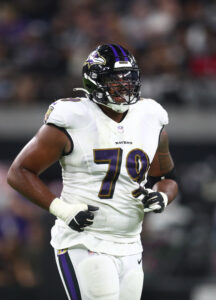 Now, he is set to enter free agency following his best and healthiest season since his devastating ankle injury in October 2020. Stanley tried to come back to start the 2021 season but played just one game before undergoing surgery for a second time. He took a more gradual approach to his return in 2022, waiting until Week 4 to start and even rotating snaps with Patrick Mekari. He missed a few weeks with another injury, but returned as the Ravens’ full-time left tackle for the rest of the year. The injury concerns continued when Stanley missed Weeks 2 to 4 in 2023 and ended the season once again rotating with Mekari.
Now, he is set to enter free agency following his best and healthiest season since his devastating ankle injury in October 2020. Stanley tried to come back to start the 2021 season but played just one game before undergoing surgery for a second time. He took a more gradual approach to his return in 2022, waiting until Week 4 to start and even rotating snaps with Patrick Mekari. He missed a few weeks with another injury, but returned as the Ravens’ full-time left tackle for the rest of the year. The injury concerns continued when Stanley missed Weeks 2 to 4 in 2023 and ended the season once again rotating with Mekari.
Stanley bounced back in 2024, starting all 17 games with a career-high 1,089 snaps. The 2016 first-round pick is still not the dominant pass protector that earned first-team All-Pro honors in 2019, but he is clearly one of the more capable left tackles in the NFL. Given the league’s scarcity at the position, Stanley will likely draw a strong market in free agency.
The Ravens may not let him get that far. Baltimore used the sixth overall pick – the franchise’s highest selection since 2000 – on Stanley in 2016 and signed him to a five-year, $98.75MM extension just three days before his 2020 injury. He has been the team’s preferred left tackle for his entire career when healthy, including the duration of the Lamar Jackson era.
With Mekari also hitting free agency, the Ravens have an uncertain future at the position. They could flip second-year tackle Roger Rosengarten to the blindside, but they would then have to replace him on the right side and deal with the bumps of two new starters on the offensive line. Re-signing Stanley would allow them to bring some continuity into 2025 and keep Rosengarten in the spot where he showed tremendous growth as a rookie. Stanley is an also an excellent fit in Todd Monken‘s offense and a respected leader in the Ravens’ locker room.
Stanley proved his value after accepting a pay cut, so he will be looking to re-establish himself as one of the league’s highest-paid left tackles. He has expressed a desire to stay in Baltimore for the rest of his career, but that doesn’t mean he will give the Ravens a hometown discount. Stanley will likely be seeking upwards of $20MM per year after Garett Bolles signed a $20.5MM APY extension with the Broncos in December. Given his injury history and struggles against elite competition like Myles Garrett and Trey Hendrickson in 2024, Stanley will likely find it difficult to break into the top tier of left tackle contracts at $22MM APY and above.
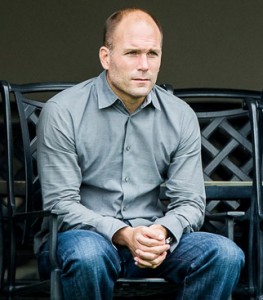 Stanley is the most proven pending free agent as his position, though a number of potential starters will be available in March. Cam Robinson and Alaric Jackson started for most of last season, while Tyron Smith, Joseph Noteboom, and Jedrick Wills all missed significant time due to injury. None played as well as Stanley in 2024, though he did benefit from Lamar Jackson‘s elite ability to evade pressure and avoid sacks.
Stanley is the most proven pending free agent as his position, though a number of potential starters will be available in March. Cam Robinson and Alaric Jackson started for most of last season, while Tyron Smith, Joseph Noteboom, and Jedrick Wills all missed significant time due to injury. None played as well as Stanley in 2024, though he did benefit from Lamar Jackson‘s elite ability to evade pressure and avoid sacks.
Unlike last year’s tackle-rich draft class, the 2025 draft has just two surefire first-round tackles: Will Campbell out of LSU and Kelvin Banks Jr. out of Texas. Neither is expected to fall to the Ravens at the 27th overall pick, and general manager Eric DeCosta is extremely unlikely to trade up. Re-signing Stanley has long seemed like Baltimore’s best and most likely option, though the team was willing to gamble with their offensive line last year.
In addition to the Ravens, Stanley could receive interest from teams like the Patriots and the Jaguars. Both teams have ample cap space this offseason and need new left tackles to protect their franchise quarterbacks. After their stunning Super Bowl defeat due to a leaky offensive line, the Chiefs could also be a dark-horse contender for Stanley’s services. However, he will be 31 by the time the 2025 regular season rolls around. The longtime Raven may very well conclude that his best fit and chance to win a championship will be in Baltimore where he has spent his entire career.
Free Agent Stock Watch: Tee Higgins
Plenty of time remains for the Bengals to prevent Tee Higgins from reaching the open market. As things stand, though, he is on track to be the top wideout available in free agency and one of the most in-demand players at any position in 2025. 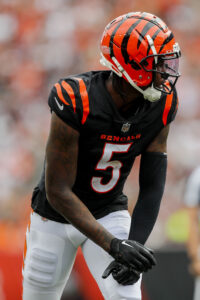
Higgins played out this past campaign on the franchise tag (making him the only recipient from 2024 who did not wind up signing a long-term deal). That is usually an indication a free agent departure is likely, and this case is believed to be no exception. Provided Cincinnati is unable to hammer out a big-ticket contract in the near future, Higgins will likely be in line for one of the league’s latest monster WR deals.
ESPN’s Dan Graziano reports an expectation is in place around the league that the 26-year-old’s next contract could be similar to those signed by Jaylen Waddle (Dolphins) and DeVonta Smith (Eagles) last spring. Waddle’s pact checks in at an annual average value of $28.25MM, while Smith’s contains a total guarantee of nearly $70MM (including $51MM in new locked-in compensation). Graziano notes Higgins could surpass those figures if he reaches the market and a bidding war ensues.
Taking things a step further, colleague Jeremy Fowler adds that many view the Clemson product’s ceiling as being at or above $30MM per year. A pact slightly outpacing Smith’s $25MM AAV is considered the starting point for a Higgins pact, but it would come as little surprise if the figure would up being notably higher. The 2025 free agent class is not teeming with young options at the WR spot in particular, so teams with excess cap space could make a serious run at signing him. The Patriots have already been named as a suitor to watch in that regard.
Higgins has surpassed 900 yards in four of his five Bengals campaigns, proving to be an effective Ja’Marr Chase complement along the way. The latter is in need of an extension, though, and resetting the receiver market (which Justin Jefferson moved to $35MM per year last offseason) may well be necessary to get a deal done. 2024 NFL sack leader Trey Hendrickson is also due a raise, one the Bengals feel they are prepared to pay.
Taking care of those priorities while also managing the cap implications of Joe Burrow‘s $55MM-per-year extension and finding the funds for Higgins will be difficult. Burrow has repeatedly campaigned for the former second-rounder to be high on the team’s to-do list, and de facto general manager Duke Tobin recently spoke about keeping Higgins. Finding the “right number” for a pact to keep him in Cincinnati will – by Tobin’s own admission – be difficult considering the deal he could command from outside parties, however.
 Jefferson and five other wideouts (CeeDee Lamb, A.J. Brown, Amon-Ra St. Brown, Tyreek Hill and Brandon Aiyuk) are attached to a deal worth at least $30MM annually. Higgins’ track record does not place him in the same category as those All-Pros, and the fact he has missed five games in both of the past two years could give certain suitors pause this spring. Still, the opportunity to secure a genuine No. 1 wideout (as he would be expected to operate as) in his prime is one teams in need of upgrading through the air will have a hard time passing up.
Jefferson and five other wideouts (CeeDee Lamb, A.J. Brown, Amon-Ra St. Brown, Tyreek Hill and Brandon Aiyuk) are attached to a deal worth at least $30MM annually. Higgins’ track record does not place him in the same category as those All-Pros, and the fact he has missed five games in both of the past two years could give certain suitors pause this spring. Still, the opportunity to secure a genuine No. 1 wideout (as he would be expected to operate as) in his prime is one teams in need of upgrading through the air will have a hard time passing up.
Higgins’ 2024 tag was worth $21.82MM, so using a second tag would cost the Bengals $26.82MM. Without the ability of spreading out the cap hit generated by that move, it should be considered unlikely at this point. The Bengals have not engaged in negotiations in quite some time, and the most recent known offer fell short of $20MM per year. How high the team is willing to go in the coming weeks will make for an intriguing storyline.
Other pending free agents at the WR position include Stefon Diggs, Chris Godwin, Amari Cooper, DeAndre Hopkins, Keenan Allen and Mike Williams. Higgins stands out compared to each of those names in terms of earning potential, whether he manages to secure a multi-year Bengals commitment or one sending him elsewhere for the first time in his career. Especially if he can approach the top of the position’s market as many feel he will, Higgins will represent the centerpiece of an acquiring team’s free agent efforts.
Free Agent Stock Watch: Diontae Johnson
Diontae Johnson’s first five seasons in the NFL saw him serve as a key figure in the Steelers’ passing attack. Receiving no fewer than 87 targets each campaign, it was not difficult to envision him remaining a central aspect of Pittsburgh’s offensive blueprint for years to come. 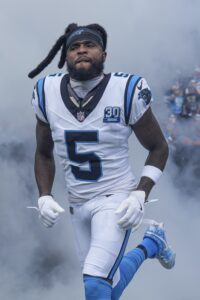
Johnson inked a two-year, $36.71MM extension in 2022 in a surprisingly short-term commitment on the part of team and player. The receiver market has erupted in recent years, with four-year pacts checking in at much higher annual rates in many cases. Johnson – one of several players on the offensive side of the ball who have been involved in incidents related to attitude and effort for the Steelers – requested a trade from Pittsburgh, though, and was dealt to Carolina ahead of the 2024 campaign.
That fresh start provided him the opportunity to work as a No. 1 option with the Panthers, a team which made several offseason moves aimed at improving on offense around quarterback Bryce Young. Johnson, 28, delivered relatively strong numbers (considering Carolina’s offensive woes) earlier in the year with three touchdowns and an 11.3 yards per catch average. The former Pro Bowler soon found himself involved in another change of scenery, however.
Johnson expressed an openness to working out a new Panthers deal, but the team did not show much urgency on that front. Ahead of the trade deadline, Carolina’s record led to calls on several pending free agents, and a willingness was shown to make changes at the WR spot with the Jonathan Mingo deal. Johnson was on board with a trade allowing him to join a contender, and one was worked out with the agreement which sent him to the Ravens. The Panthers absorbed most of his remaining compensation, but even a low acquisition cost did not yield a strong return Baltimore.
Making only four appearances with the Ravens, Johnson recorded just one reception. His refusal to enter a game in which starter Rashod Bateman was injured resulted in a one-game suspension. During the following week, the Toledo product was excused from the team before ultimately being waived. Johnson’s third team in 2024 will offer him the chance to produce in the playoffs and in doing so help recover his value to an extent.
In the wake of losing both Stefon Diggs – and, more recently – Tank Dell to ACL tears, the Texans put in a claim for Johnson. Nico Collins remains Houston’s top target, but a pathway exists for Johnson to carve out a complementary role in time for the wild-card round. He did not dress for a potential revenge game on Christmas Day against the Ravens, but Week 18 against the Titans will offer him the opportunity to get acclimated in advance of a home playoff contest soon after.
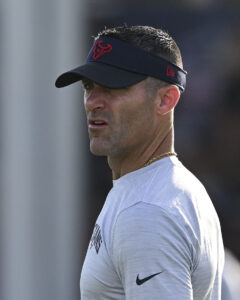 Regardless of how he fares in Houston, though, Johnson’s stock has clearly taken a major dive. As CBS Sports’ Joel Corry writes, the former third-rounder is likely on track for a ‘prove it’ pact in 2025. A one-year commitment from the Texans or another interested party will no doubt check in at a far lower rate than the $18.36MM AAV of his current deal. Diggs is a pending free agent given the removal of the post-2024 years on his contract upon arrival via trade from the Bills, but he could re-sign based on his strong showing before the injury.
Regardless of how he fares in Houston, though, Johnson’s stock has clearly taken a major dive. As CBS Sports’ Joel Corry writes, the former third-rounder is likely on track for a ‘prove it’ pact in 2025. A one-year commitment from the Texans or another interested party will no doubt check in at a far lower rate than the $18.36MM AAV of his current deal. Diggs is a pending free agent given the removal of the post-2024 years on his contract upon arrival via trade from the Bills, but he could re-sign based on his strong showing before the injury.
Collins is on the books long term, while Dell remains attached to his rookie contract (although his availability for 2025 is in question). As a result, Johnson could very well find himself changing teams once again this spring. Even with an impressive outing this week and in the playoffs, it would be a surprise if he were to generate much interest given his multiple departures in 2024. Still, teams have shown a willingness to make notable commitments on one-year pacts at the receiver position.
As Corry notes, Mike Williams landed $10MM in base value on his Jets contract in free agency last year, while Marquise Brown secured $7MM guaranteed from the Chiefs. Both deals included incentives, although Williams’ performance in New York led to a deadline trade and Brown’s SC joint injury left him sidelined for most of the season. Those cases could lead to caution on the part of suitors this spring when Johnson hits the market.
Tee Higgins is on track to be the top free agent at the WR spot in March, and he and Diggs are joined by the likes of Chris Godwin, DeAndre Hopkins and Amari Cooper as notable wideouts on expiring deals. Johnson will not garner as much interest as those options, an illustration of the extent to which his stock has fallen in very short order after his Pittsburgh days.
Free Agent Stock Watch: Russell Wilson
The Steelers opted for a complete overhaul of the quarterback position this offseason, signing Russell Wilson and trading for Justin Fields. Both passers are pending free agents, and it remains to be seen if each member of the pair will be retained for 2025. 
In Wilson’s case, though, his time in the lineup has certainly strengthened his case for a new Pittsburgh deal. The former Seahawks Super Bowl winner endured an underwhelming two-year tenure with the Broncos, leading to his release this offseason (during which Denver took on a dead money charge of $85MM). The Steelers added him on a veteran minimum pact, positioning him to operate as a low-cost Kenny Pickett replacement.
Fields started the Steelers’ first six games while Wilson recovered from a calf injury. Once the latter was healthy, head coach Mike Tomlin made the unilateral decision to insert him into the starting lineup. Pittsburgh went 4-2 with Fields at the helm, but Wilson was seen as having a higher ceiling in the passing game in particular. That has proven to be true to date, as highlighted most recently by his 414-yard outing against the Bengals in Week 13.
Overall, Wilson has led the Steelers to a 5-1 record as a starter, posting a 10:3 touchdown-to-interception ratio along the way. His 104.3 passer rating is his highest since 2020, and maintaining his current level of play would help his value on a new Pittsburgh deal this offseason or one sending him to a new team. Retaining Wilson is a priority for Pittsburgh, but an agreement on that front will only be reached after the campaign.
In the event the 36-year-old does get the opportunity to test the market, he could face a wide range of offers. Executives who communicated with CBS Sports’ Jonathan Jones were split when polled about what a Wilson offer would look like this offseason. Projections in terms of annual average value ranged from roughly $10MM on the low end to $35MM on the high end. How he and the Steelers perform over the coming weeks will obviously be key in determining Wilson’s earning potential.
The top of the QB market has seen considerable growth in recent years, and Dak Prescott‘s latest Cowboys deal made him the first $60MM-per-year player in NFL history. Eight other passers are attached to a deal averaging at least $51MM per season, while six sit between $40MM and $46.1MM. Given his age, Wilson should be expected to check in at a tier below those markers, but the likes of Geno Smith (Seahawks) and Baker Mayfield (Buccaneers) have parlayed strong seasons into healthy veteran pacts in the middle class of established starters.
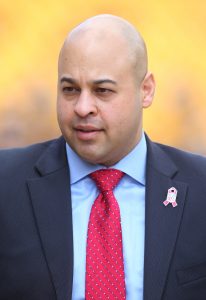 Mayfield played on a one-year, $4MM pact with Tampa Bay in 2023 before landing a three-year, $100MM contract this offseason. Wilson is not in an identical situation given his age and his Broncos compensation, but he too could turn an impressive showing on a new team into a medium-term commitment and a raise. With Wilson and Fields combining to account for only $4.44MM on Pittsburgh’s cap sheet this year, a notable spike in that figure should be in store if continuity is sought under center.
Mayfield played on a one-year, $4MM pact with Tampa Bay in 2023 before landing a three-year, $100MM contract this offseason. Wilson is not in an identical situation given his age and his Broncos compensation, but he too could turn an impressive showing on a new team into a medium-term commitment and a raise. With Wilson and Fields combining to account for only $4.44MM on Pittsburgh’s cap sheet this year, a notable spike in that figure should be in store if continuity is sought under center.
Sam Darnold took a one-year Vikings pact as a potential springboard to a lucrative deal elsewhere, and his success in Minnesota has him on track to be the top quarterback in the 2025 free agent market. Wilson could join him as an older option for teams not in position to add a first-round passer in the draft or those seeking a bridge starter to partner with a developmental QB. Fields could also represent an intriguing free agent candidate in the event he were to depart.
The Steelers have not managed to find a long-term Ben Roethlisberger replacement since his retirement, and Wilson will likely not serve in that capacity far beyond 2025 even if he is retained given where he is in his career. Still, he could be an intriguing free agent in the event the Steelers were to allow him to test the market.
Free Agent Stock Watch: Sam Darnold
The Vikings are the NFC’s only remaining undefeated team, and their play on offense has been a key factor in that early-season success. Specifically, the performance of quarterback Sam Darnold has raised eyebrows given how he was expected to perform in 2024. 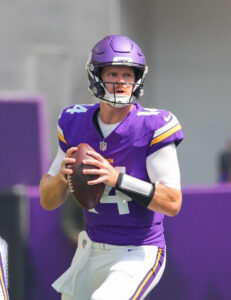
Selected third overall in 2018 – after the Jets traded up from the No. 6 slot – Darnold faced the task of becoming a franchise passer. That has proven to be the case for Josh Allen and Lamar Jackson (selected later in the first round that year), but he was unable to develop into a long-term answer under center in New York. The USC product was immediately used in a first-team role but compiled a 13-25 record while completing less than 60% of his passes in the process.
The Jets elected to reset at quarterback in 2021, the year they selected Zach Wilson to start what turned out to be another unsuccessful run at finding a solution at the QB spot. Darnold was dealt to the Panthers for a package of three draft picks, including a second-rounder the following year. That agreement showed he still had some value, albeit far less than what New York originally invested in him. Darnold’s first Panthers season resulted in another losing record along with a 9:13 touchdown-to-interception ratio, however.
Baker Mayfield was added during the subsequent offseason, and 2018’s top selection handled starting duties to begin the 2022 campaign. One week before Mayfield’s release request was granted, though, Darnold took back over as the Panthers’ starter. Carolina won four of six games down the stretch with the latter posting a triple-digit passer rating four times. The team was committed to a more permanent solution than Darnold, a pending free agent, though. Carolina therefore embarked on the blockbuster deal which yielded the No. 1 pick (Bryce Young), something which – to put it mildly – has not gone according to plan so far.
Darnold took a one-year deal in 2023 to serve as the 49ers’ backup. Brock Purdy remained healthy throughout the season, though, so Darnold’s only start game in a meaningless Week 18 contest. His San Francisco tenure did not include eye-popping statistics, but it was sufficient to draw interest from the Broncos and Commanders before a Vikings pact was worked out. The one-year agreement carried a $10MM value, second only to Gardner Minshew in terms of pacts for signal-callers taking backup/bridge starter pacts.
First-round rookie J.J. McCarthy entered training camp behind Darnold on the depth chart, putting the latter on track to handle first-team duties early in the 2024 season. McCarthy’s meniscus tear shut him down for the campaign, however, leaving Darnold in place to guide an offense no longer led by Kirk Cousins. Through one month, things have gone very well without Pro Bowl tight end T.J. Hockenson even being in the picture.
Darnold leads the league in touchdown passes (11), yards per attempt (9.6) and passer rating (118.9) early in the campaign. Those figures – along with a career-high 68.9 completion percentage – helped him earn the NFC’s Offensive Player of the Month award for September. If that run of form can continue, a healthy free agent spell will be in store next offseason.
Multiple front office personnel predicted to Outkick’s Armando Salguero the Vikings will make a push to retain Darnold in 2025 despite McCarthy being attached to his rookie contract for the foreseeable future. Minnesota’s offense continuing to thrive would assist Darnold’s bargaining power considerably (not to mention help head coach Kevin O’Connell’s chances of landing an extension alongside general manager Kwesi Adofo-Mensah). A strong showing could prove Darnold to be the league’s next Mayfield – that is, a passer turning a one-year gig into a multi-year commitment from his team. Mayfield seemed to be on track for free agency before he agreed to a three-year, $100MM Buccaneers pact (including $40MM guaranteed) this past March.
 Given his age, Darnold could command a similar deal provided his encouraging performance holds up over the coming months. McCarthy’s presence would complicate considerations on the Vikings’ part with respect to a deal covering 2025 and (quite possibly) multiple years after that for Darnold, but as always a number of teams will be in the market for a veteran passer in free agency. Any which do not figure to have a high first-round draft pick could make a notable push on a multi-year offer.
Given his age, Darnold could command a similar deal provided his encouraging performance holds up over the coming months. McCarthy’s presence would complicate considerations on the Vikings’ part with respect to a deal covering 2025 and (quite possibly) multiple years after that for Darnold, but as always a number of teams will be in the market for a veteran passer in free agency. Any which do not figure to have a high first-round draft pick could make a notable push on a multi-year offer.
The executives Salguero spoke with agreed an asking price from Darnold’s camp breaching the $50MM-per-year mark (as nine recent QB deals have) would be untenable. An AAV closer to the high $30MM- or low $40MM-point may be on the table, though, depending on structure and guarantees of course. Especially if Justin Fields lands a new Steelers agreement – something which certainly seems feasible at this point – Darnold would loom as the clear top free agent option amongst veteran passers for Minnesota or any number of other teams.
A regression over the coming games would not leave Darnold in danger of losing his starting spot but it would obviously hinder his market value. As things currently stand, however, he is on track to benefit greatly from his mid-career turnaround.
Free Agent Stock Watch: Geno Smith
With the Seahawks’ season now over, attention will turn away from the team’s surprising trip to the playoffs and towards an offseason filled with questions at the quarterback position. Geno Smith played his way into a significant raise in 2023, but whether he will remain in Seattle will be a key storyline. 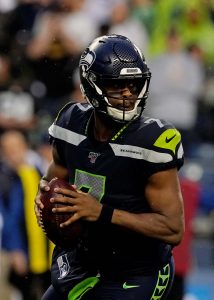
Smith, 32, flamed out as the Jets’ starter after two seasons in New York. That span was followed by six straight campaigns spent as a backup, the role he was expected to remain in for the duration of his NFL career. His play while briefly filling in for Russell Wilson in 2021 made it unsurprising that he was brought back on a one-year deal this past offseason, but the base value of that contract ($3.5MM) made the team’s intentions clear.
It was former Bronco Drew Lock – part of the package Denver sent Seattle in the blockbuster Wilson trade – who was expected to earn the No. 1 spot over the course of the summer. Instead, Smith won out the training camp competition, and quickly rewarded the Seahawks for putting their trust in him. By Week 6, it was reported that a full-time commitment to the West Virginia alum could be in the cards.
Smith generally continued his impressive play throughout the season, one in which the Seahawks were able to clinch the NFC’s final playoff spot during Week 18 despite expectations being tempered considerably in the wake of Wilson’s (and All-Pro linebacker Bobby Wagner’s) absence. Smith led the league in completion percentage (69.8%), throwing for a franchise-record 4,282 yards along the way. His performance earned him a Pro Bowl nod and allowed him to double his earnings through incentives. That $7MM price tag will surely be comfortably exceeded in free agency – something the veteran is acutely aware of.
“Football is a business,” Smith said prior to today’s 41-23 loss to the 49ers, via ESPN’s Brady Henderson. “A lot of people have a lot of decisions to make, and that’s where I’ll leave it at. I feel great about where I stand with this organization and my teammates and everybody else, but it’s always a business first. So I look at it like that. I understand that, and I’ve got to handle my business as well.”
The Seahawks currently rank in the top-five in the league in terms of 2023 cap space after transitioning to a younger core at most positions. That has them well-positioned to absorb a new deal for Smith carrying a significant raise, but it could also pave the way for a contract keeping Lock in the Emerald City for the short- or medium-term future. Head coach Pete Carroll routinely praised the 26-year-old upon his arrival, despite his underwhelming tenure with the Broncos. Lock is also a pending UFA, though his market will be clouded by having sat as Smith’s backup all season.
In any event, the Seahawks have reportedly been convinced by Smith’s performance to commit to him on a new contract. An alternative, especially in light of his unique rise back to a starter’s role after years as a No. 2, could be a franchise or transition tag, which Ian Rapoport of the NFL Network confirms is a real possibility (video link). Where Smith’s next deal comes from – and what form it takes – will certainly be worth watching over the coming weeks.
For what it’s worth, Smith himself said after the ‘Hawks wildcard round loss to the 49ers that he wants to finish his career in Seattle and that he expects to be back with the team in 2023 (via Henderson).
Free Agent Stock Watch: Daniel Jones
Bounce-back seasons from Saquon Barkley and Daniel Jones represent the main on-field reason the Giants are close to becoming one of the more surprising playoff teams in recent memory. Injury issues have dogged the would-be rebuilding squad throughout, but the play of their now-two-time Pro Bowl running back and fourth-year quarterback has them at 8-6-1. The Giants hold a 92% chance, per FiveThirtyEight, of making the playoffs for the first time since 2016.
The subject of Barkley and Jones’ future looms, however. Both Giants offensive cornerstones are on track for free agency. This situation reminds of the Titans’ quandary in 2020, when they had both Derrick Henry and the resurgent Ryan Tannehill as UFAs-to-be. Tennessee franchise-tagged its All-Pro running back and re-signed its resurgent starting QB. Will the Giants try to play this the same way?
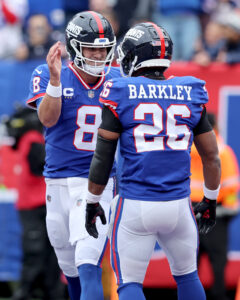 On the Barkley front, that would be the simplest solution. Next year’s running back tag is projected to come in at $10.1MM — a steep drop from the projected nonexclusive QB tag of $32.5MM. A $10.1MM tag, as a bridge to a top-market extension, would not clog New York’s cap. After needing to jettison veterans this year for cap purposes, with Barkley trade talks even emerging, the Giants are projected to hold nearly $60MM in cap space. That number sits in the top three for 2023.
On the Barkley front, that would be the simplest solution. Next year’s running back tag is projected to come in at $10.1MM — a steep drop from the projected nonexclusive QB tag of $32.5MM. A $10.1MM tag, as a bridge to a top-market extension, would not clog New York’s cap. After needing to jettison veterans this year for cap purposes, with Barkley trade talks even emerging, the Giants are projected to hold nearly $60MM in cap space. That number sits in the top three for 2023.
The Giants already turned down Jones’ fifth-year option. This was before he showed considerable progress in Brian Daboll‘s offense, but still. A team that passed on a $22MM Jones option salary circling back to tag him for $10MM more would represent a strange path — and one that would hamstring Big Blue come free agency. But the Giants’ Jones situation, especially with the team on the brink of a wild-card spot, will be a key 2023 subplot.
The 2011 CBA introduced the fifth-year option for first-rounders, and the first batch of decisions arrived in 2014. From then until 2022, no team has passed on a quarterback’s fifth-year option and later re-signed him. Christian Ponder, Blaine Gabbert, Jake Locker, Brandon Weeden, Robert Griffin III, EJ Manuel, Teddy Bridgewater, Johnny Manziel, Paxton Lynch, Mitch Trubisky, Dwayne Haskins and Josh Rosen either played out their four-year rookie deals or were moved off the roster before those contracts expired. Jones’ efficient fourth season could break some new NFL ground, but the sides will need to come together on an atypical deal — one that may land in currently uninhabited QB salary territory.
Tannehill re-signed with the Titans on a four-year, $118.5MM deal just before the 2020 league year began. The former top-10 Dolphins draftee was coming off a stunning season in his first Titans campaign, piloting the Titans to the AFC championship game. Jones has rocketed from 22nd in QBR last season to 11th this year, but the Giants’ pass-catching cadre has capped his rise to a degree. Jones has 13 touchdown passes in 15 games. Despite a ransacked receiving arsenal, the former No. 6 overall pick has limited his turnovers. Jones’ 1.1 interception rate is the league’s best mark. He is completing 66.5% of his passes, albeit at just 6.8 yards per attempt, and has already established a new career rushing high (617 yards). This still would qualify as more workmanlike season than true breakthrough, but the Giants equipping Jones with better pass catchers could unlock another level for the oft-doubted Duke product.
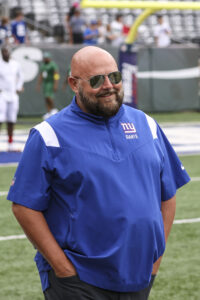 Jones’ history, present production and ties to the Dave Gettleman regime complicate a potential Joe Schoen-led negotiation. The rookie GM said the Giants discussed a deal with Barkley but not Jones during their bye week, indicating a clear priority hierarchy. That would make sense, given the first-rounders’ accomplishments. Only one quarterback (Tom Brady, an outlier in just about every way) is tied to an average salary between $14MM and $29.5MM. That is a pretty wide range to explore.
Jones’ history, present production and ties to the Dave Gettleman regime complicate a potential Joe Schoen-led negotiation. The rookie GM said the Giants discussed a deal with Barkley but not Jones during their bye week, indicating a clear priority hierarchy. That would make sense, given the first-rounders’ accomplishments. Only one quarterback (Tom Brady, an outlier in just about every way) is tied to an average salary between $14MM and $29.5MM. That is a pretty wide range to explore.
Last week’s YouTube TV Sunday Ticket agreement should soon provide cap clarity, but teams are operating as if the cap will come in between $222MM and $225MM. That estimate is nearly $30MM north of where the cap was when Tannehill inked his deal, and Jones guiding this Giants team to the postseason could prompt him — his struggles from 2019-21 notwithstanding — to ask for a contract worth more than $30MM per year. Four passers (Kirk Cousins, Jared Goff, Carson Wentz, Matt Ryan) are tied to deals averaging between $30-$35MM per year; those deals sit 10th-13th on the quarterback salary spectrum. Such an ask would test the Giants.
If the Giants let Jones reach free agency, they will not be in a good position to draft his replacement. They are set to pick outside the top 10 for the first time since 2017. The past three offseasons have brought tremendous QB movement, opening new doors for teams seeking upgrades. The free agent market is tentatively slated to include Brady, Jimmy Garoppolo, Geno Smith, Jacoby Brissett and Mike White. Brady has not committed to 2023 and would not seem to line up with the Giants’ timeline, while the Seahawks want to keep Smith. UFA-to-be Lamar Jackson will not hit the market.
Tannehill and Derek Carr seem the two likeliest trade candidates of note; the Raiders look to have ignited the Carr market by benching him Wednesday. Both players have proven far more than Jones, but each is much older. The Titans passer will be 35 next season; the now-separated Raiders QB will be 32. Jones will turn 26 in 2023. Carr has obviously proven much more than Jones, and it will be interesting to see if the Giants are connected to him. But Jones has outplayed Carr (league-high 14 INTs) this season and almost certainly will not require a $40MM-per-year contract. How much will it ultimately take to keep him off the market?
The Giants eschewing the trade or free agency routes and focusing on Jones could produce another prove-it season — likely with better receivers — on a one-year deal. The team could also go through with a medium-term agreement, with CBS Sports’ Joel Corry comparing this situation to the Jaguars’ Blake Bortles talks in 2018. The Jags gave their shaky starter a three-year, $54MM deal that included $26.5MM fully guaranteed. With that contract occurring under a $177.2MM salary cap, a similar Jones arrangement would undoubtedly check in with a much higher value — likely north of $25MM AAV.
If the price escalates much further, the Giants might be inclined to examine other options. The Bortles re-signing did not age well, and Jacksonville took on dead money by cutting him a year later. That mid-tier investment shows the risks of betting on an inconsistent quarterback, but the Giants going in the other direction could disrupt the Daboll-, Jones- and Barkley-geared ascent this year’s team has made.
Whether the Giants’ new regime pays Jones or tries to acquire an upgrade, the team’s 2022 improvement and the Jones-Barkley free agency challenge will give Big Blue a much higher profile entering the 2023 offseason compared to where the franchise resided over the past several years.
Free Agent Stock Watch: David Montgomery
Bears running back David Montgomery will soon experience the challenges of a free agent running back in today’s NFL. A third-round draft pick in the 2019 NFL Draft, Montgomery is currently in a contract year for a team that may not have reason to commit to him long-term. The final few games of the season could determine how the next stage of Montgomery’s career plays out. 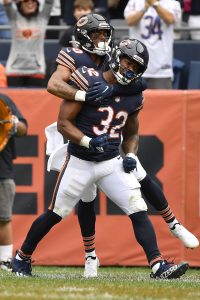
Montgomery entered this season as the Bears’ No. 1 running back with backup Khalil Herbert providing the team with a strong secondary option. Montgomery had produced two strong seasons to kick off his career. As a rookie starting eight games, Montgomery racked up 889 rushing yards and six rushing touchdowns, adding 185 yards and a touchdown through the air as a receiving back. In his sophomore season, Montgomery showed a ton of promise, rushing for 1,070 yards and eight touchdowns and catching 54 passes for 438 yards and two touchdowns.
Last year, Chicago drafted Herbert in the sixth-round to supplement their rushing attack. Montgomery’s production slipped a bit as Herbert shared some of the offense, but he still produced 849 rushing yards and seven rushing touchdowns and showed he was the top receiving back with 301 yards on 42 catches. Herbert got his opportunities, though, and contributed 433 rushing yards and two touchdowns as a rookie.
This year the story has changed a little bit. Despite the fact that, coming into today’s game, Montgomery had started all but one game and appeared in two more games than Herbert, who had missed the team’s last three games with a hip injury, Montgomery trailed Herbert by two rushing yards. Montgomery plays about 67% of the Bears’ offensive snaps on average, while Herbert averages around 37%. Still, until today’s loss against the Eagles, the backup running back, Herbert, was outgaining the starting running back, Montgomery, with an average rushing yards per game of 64.3 to 53.4. Montgomery has maintained his role as the team’s top receiving back this season.
After sitting out of his fourth straight game today, Herbert is set to return next week to help Chicago in its last three games of the regular season. Montgomery will have a bit of an added challenge in the final few games of the season to show his worth to the Bears offense with his more-productive teammate back in the lineup. At 3-11, already eliminated from postseason contention, Montgomery will only have the final three games of the regular season to make his case.
If Montgomery hits free agency, he will join a stacked free agent class of running backs. After his fifth-year option was declined, Raiders running back Josh Jacobs will be a free agent this offseason. Barring any new extensions before the end of the season, Giants running back Saquon Barkley, Eagles running back Miles Sanders, and Cowboys running back Tony Pollard will all join Montgomery and Jacobs on the free agent market. Additionally, key contributors in Browns running back Kareem Hunt, Lions running back Jamaal Williams, Bills running back Devin Singletary, and Patriots running back Damien Harris will all hit free agency, as well. Even a score of reliable backups will be available in Minnesota’s Alexander Mattison, Cincinnati’s Samaje Perine, New York’s James Robinson, Miami’s Raheem Mostert, and Carolina’s D’Onta Foreman.
Needless to say, Montgomery will have a ton of competition in the free agent market. Regardless of the competition, what would a deal with Montgomery look like? Realistically, these days, for a running back that isn’t a super star, a three-year deal is standard. Star backs are set to earn around $14MM to $16MM per year, perhaps more if a suitor wants to set the market high for a free agent target. Strong starters will earn around $10MM to $13MM and second-tier backs will be in the range of about $6MM to $8MM.
Statistically compared to recent contracts, Montgomery matches up closest with a player like Buccaneers running back Leonard Fournette. Fournette recently signed a three-year, $21MM deal after a contract year that could look vaguely similar to what Montgomery is projected to do this year. There are two factors in Montgomery’s favor, though. Montgomery doesn’t have the significant injury history that Fournette does, and Montgomery has been far more consistent with his production year in, year out. This could point to either a three-year deal with a slightly larger average annual value or a similar annual amount with another year tacked on. If Montgomery were in a vacuum, he would likely demand something like a three-year, $24MM contract or a four-year, $28MM deal.
Unfortunately for Montgomery, he is not in a vacuum. With the excessive amount of competition he will face in the free agent market, Montgomery’s value may be diluted. It will be hard to convince a team to shell out big money for Montgomery if they can just sign a lesser deal to one of many options. This may lead Montgomery to seek a team-friendly deal in order to stay in Chicago. With the existing connection and chemistry, Montgomery may be able to get more value out of his current team than he would testing the markets.
Taking all of this into account, Montgomery still will likely earn a three-year contract, possibly even four- with his superior durability. In a diluted market or in a team friendly deal, I could see Montgomery signing with an average annual value of $6MM or $7MM. It would make sense to see Montgomery end up with a three-year, $19.5MM or four-year, $24MM deal this offseason. Whether he wants to stand pat in Chicago or test the free agent waters, Montgomery will have three more games to show what he’s worth.
Free Agent Stock Watch: WR Will Fuller
Will Fuller has had an up-and-down NFL career to date, and it may now stand at something of a crossroads. He currently finds himself among an interesting crop of free agent receivers seeking new deals well after teams have done the bulk of their roster retooling. 
After two straight hugely productive seasons to finish his college career at Notre Dame, in which he totalled over 2,300 yards and 29 touchdowns, Fuller was one of the top receiver prospects in the 2016 draft class. He was the second wideout to hear his name called, going 21st overall to the Texans. That set him up in a favorable situation to begin his pro career.
Landing in Houston allowed Fuller to serve as an effective compliment to DeAndre Hopkins, given his vertical speed and field-stretching ability. He was an integral part of the team’s passing offense during his rookie season, as he saw a career-high 92 targets. Unfortunately, that year was also the one in which he saw the most time on the field, appearing in 14 contests.
Injuries have been a constant in the 28-year-old’s NFL tenure, unlike those final two years in college which made him so highly regarded. During his five seasons in Houston, he missed 27 total games, mostly due to injury. Part of that total also came from a six-game PED suspension, which was handed down late in the 2020 season. Despite the missed time, Fuller still put up career-best totals that year in receptions (53), yards (879) and touchdowns (eight).
That made him one of the top available free agents last offseason, as he hit the open market for the first time in his career. He signed with the Dolphins, a team which also added Jaylen Waddle in the draft as part of their WR overhaul. The deal carried a value of over $10MM, but was only one year in length and included incentives, as the team clearly had concerns about his availability.
Those proved to be well-founded; after missing the first week of the season due to the suspension, Fuller was also absent for Week 2 as a result of a non-injury-related matter. In October, he then suffered a broken finger, adding further to the list of ailments which have proved increasingly cumbersome to his career. The injury wasn’t expected to end his season, but it ultimately did limit him to just two games played. After recording four scoreless receptions, it comes as little surprise that Fuller is still a free agent this late into free agency.
As shown by his 16.6 yards per catch average in 2020, though, he has the ability to make a significant impact as a complimentary receiver when healthy. That qualifies him as one of the best remaining wideouts on the market, as the likes of Julio Jones and Odell Beckham Jr. have significant injury concerns of their own. A number of teams looking for veteran pass-catchers could stand to add him.
One such team is the Ravens, who were recently named as a logical destination for Fuller. The team traded away Marquise Brown during the draft, so they could use him as a replacement for Brown’s speed. Baltimore currently ranks second-last in the league in cap space, however, so any deal would need to be a short-term, low-cost one like that given to Sammy Watkins last year.
Other potential landing spots include the Colts (who have yet to re-sign T.Y. Hilton, or a similar compliment to Michael Pittman Jr.) and Packers (who considered trading for Fuller in 2020 and lost their top two WRs this offseason). Wherever he signs, Fuller could prove to be an effective addition given the right team fit and a bit of injury-related luck.
